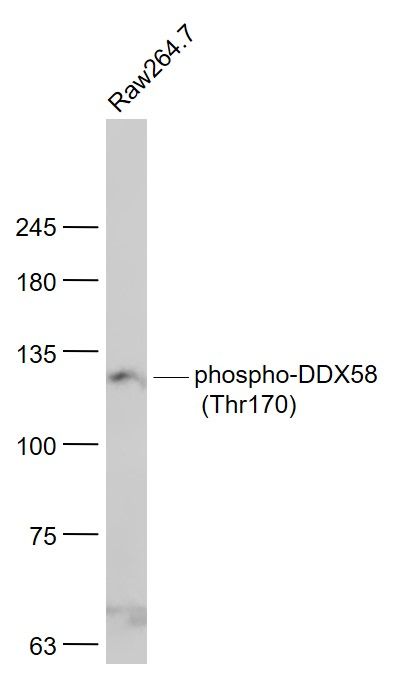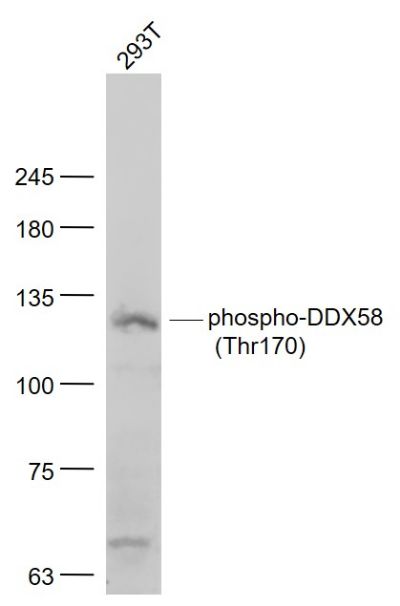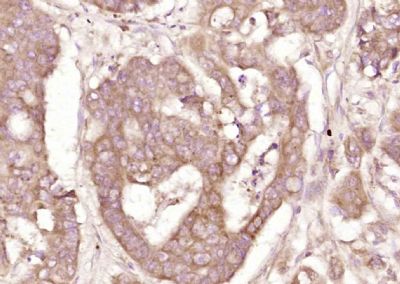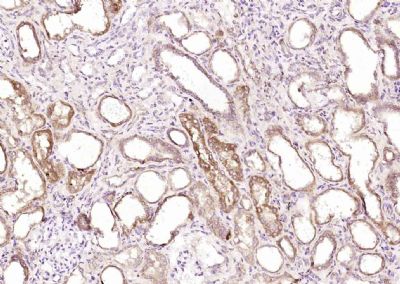| 中文名稱 | 磷酸化DDX58抗體 |
| 別 名 | p-DDX58 (Thr170); DEAD/H (Asp-Glu-Ala-Asp/His) box polypeptide RIG-I; DKFZp434J1111; DKFZp686N19181; FLJ13599; C330021E21; OTTHUMP00000045225; DEAD (Asp-Glu-Ala-Asp) box polypeptide 58; DEAD (Asp Glu Ala Asp/His) box polypeptide; DEAD box protein 58; Probable ATP dependent RNA helicase DDX58; Retinoic acid inducible gene 1 protein; RIG I; rig-I; RIG1; rigi; RNA helicase. |
| 產(chǎn)品類型 | 磷酸化抗體 |
| 研究領(lǐng)域 | 腫瘤 免疫學(xué) 信號(hào)轉(zhuǎn)導(dǎo) 細(xì)胞凋亡 |
| 抗體來(lái)源 | Rabbit |
| 克隆類型 | Polyclonal |
| 交叉反應(yīng) | Human, Mouse, (predicted: Dog, Pig, Cow, Horse, Rabbit, Sheep, ) |
| 產(chǎn)品應(yīng)用 | WB=1:500-2000 ELISA=1:500-1000 IHC-P=1:100-500 IHC-F=1:100-500 IF=1:100-500 (石蠟切片需做抗原修復(fù)) not yet tested in other applications. optimal dilutions/concentrations should be determined by the end user. |
| 分 子 量 | 106kDa |
| 細(xì)胞定位 | 細(xì)胞漿 |
| 性 狀 | Liquid |
| 濃 度 | 1mg/ml |
| 免 疫 原 | KLH conjugated Synthesised phosphopeptide derived from human DDX58 around the phosphorylation site of Thr170:PK(p-T)LK |
| 亞 型 | IgG |
| 純化方法 | affinity purified by Protein A |
| 儲(chǔ) 存 液 | 0.01M TBS(pH7.4) with 1% BSA, 0.03% Proclin300 and 50% Glycerol. |
| 保存條件 | Shipped at 4℃. Store at -20 °C for one year. Avoid repeated freeze/thaw cycles. |
| PubMed | PubMed |
| 產(chǎn)品介紹 | The innate immune system detects viral infection by recognizing various viral components and triggers antiviral responses. Like the toll-like receptor 3 (TLR3), the cytoplasmic helicase retinoic acid inducible gene protein 1 (RIG1/DDX58) recognizes double-stranded (ds) RNA, a molecular pattern associated with viral infection. Unlike TLR3 however, RIG1/DDX58 activates the kinases TBK1 and IKKe through the adaptor protein IPS1. These kinases then phosphorylate the transcription factors IRF3 and IRF7 which are essential for the expression of type-I interferons. RIG1/DDX58 is required for the production of interferons in response to RNA viruses including paramyxoviruses, influenza virus, and Japanese encephalitis virus. Function: Involved in innate immune defense against viruses. Upon interaction with intracellular dsRNA produced during viral replication, triggers a transduction cascade involving MAVS/IPS1, which results in the activation of NF-kappa-B, IRF3 and IRF7 and the induction of the expression of antiviral cytokines such as IFN-beta and RANTES (CCL5). Detects dsRNA produced from non-self dsDNA by RNA polymerase III, such as Epstein-Barr virus-encoded RNAs (EBERs). Essential for the production of interferons in response to RNA viruses including paramyxoviruses, influenza viruses, Japanese encephalitis virus and HCV. Subunit: Monomer; maintained as a monomer in an autoinhibited state. Upon viral dsRNA binding and conformation shift, homomultimerizes and interacts with MAVS. Interacts with DHX58/LGP2, IKBKE, TBK1 and TMEM173/STING. Interacts (via CARD domain) with TRIM25 (via SPRY domain). Interacts with RNF135. Interacts with CYLD. Interacts with NLRC5; blocks the interaction of MAVS to DDX58. Interacts with SRC. Subcellular Location: Cytoplasm. Note=Colocalized with TRIM25 at cytoplasmic perinuclear bodies. Tissue Specificity: Present in vascular smooth cells (at protein level). Post-translational modifications: Phosphorylated in resting cells and dephosphorylated in RNA virus-infected cells. Phosphorylation at Thr-770, Ser-854 and Ser-855 results in inhibition of its activity while dephosphorylation at these sites results in its activation. Isgylated. Conjugated to ubiquitin-like protein ISG15 upon IFN-beta stimulation. Ubiquitinated. Undergoes 'Lys-48'- and 'Lys-63'-linked ubiquitination. Lys-172 is the critical site for TRIM25-mediated ubiquitination, for MAVS/IPS1 binding and to induce anti-viral signal transduction. Lys-154, Lys-164 and Lys-172 are critical sites for RNF135-mediated ubiquitination. Deubiquitinated by CYLD, a protease that selectively cleaves 'Lys-63'-linked ubiquitin chains. Also probably deubiquitinated by USP17L2/USP17 that cleaves 'Lys-48'-and 'Lys-63'-linked ubiquitin chains and positively regulates the receptor. Similarity: Belongs to the helicase family. Contains 2 CARD domains. Contains 1 helicase ATP-binding domain. Contains 1 helicase C-terminal domain. SWISS: O95786 Gene ID: 23586 Database links: Entrez Gene: 23586 Human Entrez Gene: 230073 Mouse Entrez Gene: 297989 Rat Omim: 609631 Human SwissProt: O95786 Human SwissProt: Q6Q899 Mouse Unigene: 190622 Human Unigene: 86382 Mouse Important Note: This product as supplied is intended for research use only, not for use in human, therapeutic or diagnostic applications. |
| 產(chǎn)品圖片 |  Sample: Sample:Raw264.7(Mouse) Cell Lysate at 30 ug Primary: Anti- phospho-DDX58 (Thr170) (bs-5300R) at 1/1000 dilution Secondary: IRDye800CW Goat Anti-Rabbit IgG at 1/20000 dilution Predicted band size: 102 kD Observed band size: 120 kD  Sample: Sample:293T(Human) Cell Lysate at 30 ug Primary: Anti- phospho-DDX58 (Thr170) (bs-5300R) at 1/1000 dilution Secondary: IRDye800CW Goat Anti-Rabbit IgG at 1/20000 dilution Predicted band size: 102 kD Observed band size: 120 kD  Paraformaldehyde-fixed, paraffin embedded (human cervical carcinoma); Antigen retrieval by boiling in sodium citrate buffer (pH6.0) for 15min; Block endogenous peroxidase by 3% hydrogen peroxide for 20 minutes; Blocking buffer (normal goat serum) at 37°C for 30min; Antibody incubation with (phospho-DDX58 (Thr170)) Polyclonal Antibody, Unconjugated (bs-5300R) at 1:200 overnight at 4°C, followed by operating according to SP Kit(Rabbit) (sp-0023) instructionsand DAB staining. Paraformaldehyde-fixed, paraffin embedded (human cervical carcinoma); Antigen retrieval by boiling in sodium citrate buffer (pH6.0) for 15min; Block endogenous peroxidase by 3% hydrogen peroxide for 20 minutes; Blocking buffer (normal goat serum) at 37°C for 30min; Antibody incubation with (phospho-DDX58 (Thr170)) Polyclonal Antibody, Unconjugated (bs-5300R) at 1:200 overnight at 4°C, followed by operating according to SP Kit(Rabbit) (sp-0023) instructionsand DAB staining. Paraformaldehyde-fixed, paraffin embedded (Human kidney); Antigen retrieval by boiling in sodium citrate buffer (pH6.0) for 15min; Block endogenous peroxidase by 3% hydrogen peroxide for 20 minutes; Blocking buffer (normal goat serum) at 37°C for 30min; Antibody incubation with (phospho-DDX58 (Thr170)) Polyclonal Antibody, Unconjugated (bs-5300R) at 1:200 overnight at 4°C, followed by operating according to SP Kit(Rabbit) (sp-0023) instructionsand DAB staining. Paraformaldehyde-fixed, paraffin embedded (Human kidney); Antigen retrieval by boiling in sodium citrate buffer (pH6.0) for 15min; Block endogenous peroxidase by 3% hydrogen peroxide for 20 minutes; Blocking buffer (normal goat serum) at 37°C for 30min; Antibody incubation with (phospho-DDX58 (Thr170)) Polyclonal Antibody, Unconjugated (bs-5300R) at 1:200 overnight at 4°C, followed by operating according to SP Kit(Rabbit) (sp-0023) instructionsand DAB staining. |
我要詢價(jià)
*聯(lián)系方式:
(可以是QQ、MSN、電子郵箱、電話等,您的聯(lián)系方式不會(huì)被公開(kāi))
*內(nèi)容:









